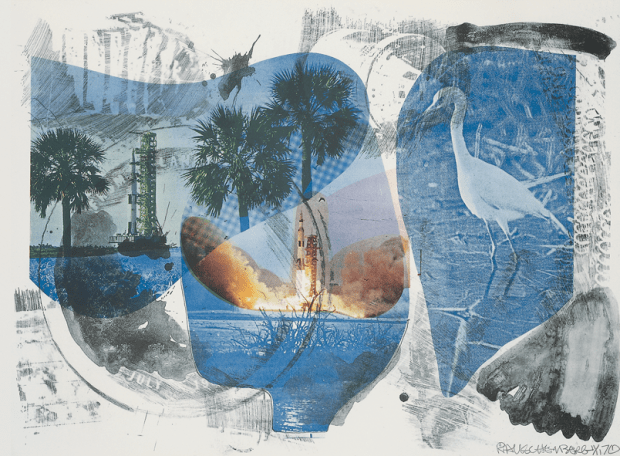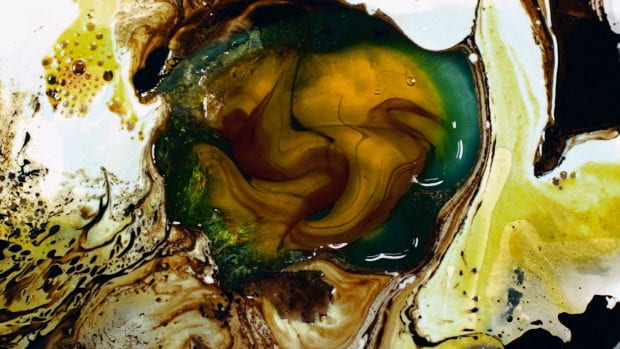Rice University
Office of Public Affairs / News & Media Relations
MEDIA ADVISORY
Katharine Shilcutt
713-348-6760
kshilcutt@rice.edu
Moody Center’s ‘Moon Shot’ exhibition will celebrate Apollo-inspired art
Rauschenberg and Warhol works will anchor fall lineup beginning Sept. 21
HOUSTON – (July 22, 2019) – Rare Robert Rauschenberg lithographs from 1969 — including the largest ever made at the time — and an unfinished series by Andy Warhol will be among the pieces on exhibit at Rice University’s Moody Center for the Arts this fall.
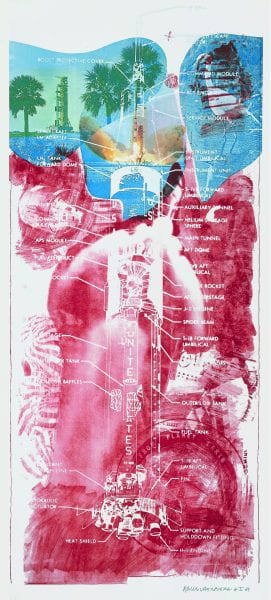
Robert Rauschenberg, “Sky Garden,” 1969. 6-color lithograph / screenprint on Arjomari paper 89 x 42” (226.1 x 106.7 cm). Edition of 35 plus 6 APs. © Robert Rauschenberg Foundation and Gemini G.E.L.
“Moon Shot” debuts Sept. 21 featuring works that reflect on the 50th anniversary of the Apollo 11 moon landing, showing how artists past and present have responded to a moment that changed popular culture.
Included in the exhibit encompassing all three of the Moody Center’s galleries will be Rauschenberg’s “Stoned Moon” series of 34 lithographs, shown together as a group for the first time since their creation in 1969-70, when the Port Arthur native and painter served as artist-in-residence at NASA.
Warhol’s “Moonwalk” represents the Apollo 11 moon landing as an iconic moment in television history, employing the same image that inspired MTV’s famous Moonman logo. Multimedia artist Laurie Anderson’s virtual reality work “To the Moon” allows visitors to take their own experimental journey through space without leaving the Central Gallery.
Rice has a long and storied history with America’s space program. Rice Stadium was the site of President John F. Kennedy’s famous “We choose to go to the moon” speech in 1962. The university has developed a close affiliation with space science and policy through its physics department, the Rice Space Institute, the Baker Institute for Public Policy and individual faculty and alumni who have worked closely with the space program.
“Given this important anniversary as well as the interdisciplinary mission of the Moody, we’re featuring innovative works that respond to both the poetic and technical aspects of space travel,” said Alison Weaver, the Suzanne Deal Booth Executive Director of the Moody Center.
Additional programming inspired by the Apollo 11 anniversary will run throughout the fall semester, concluding with the second annual Moody Movie Night, projected outdoors on the building’s west wall. “Interstellar” will be screened on Dec. 6 and “Gravity” will play on Dec. 7. Screenings begin at 7 p.m. They’re free and open to the public.
‘Moon Shot’
Sept. 20-Dec. 21
Central, Brown Foundation and Media Galleries
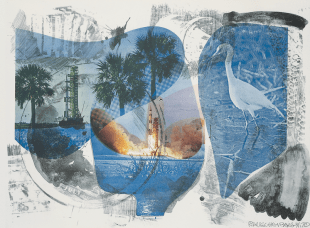
Robert Rauschenberg, “Local Means (Stoned Moon),” 1970, Lithograph, 32 3/8 x 43 1/4 inches (82.2 x 110 cm). From an edition of 11, published by Gemini G.E.L., Los Angeles © Robert Rauschenberg Foundation and Gemini G.E.L.
“Moon Shot” is anchored by the historic presentation of “Stoned Moon,” a series of lithographs by Rauschenberg (1925-2008) that will be shown together for the first time at the Moody. As an artist-in-residence with NASA in 1969, Rauschenberg observed the Apollo 11 mission firsthand. In response, he created a series of 34 prints at Gemini G.E.L. in Los Angeles between 1969 and 1970. At the time of its printing, the series’ “Sky Garden” (1969) was the largest lithograph ever made; it was more than 7 feet tall, requiring a technical innovation in printmaking concurrent with the historic advancements in space travel.
Laurie Anderson, like Rauschenberg, was an artist-in-residence with NASA from 2002-04. The moon has continued to be a source of inspiration and creative inquiry, as evidenced by her recent work “To the Moon” (2018). Co-created with Taiwanese filmmaker Hsin-Chien Huang, the 15-minute virtual reality experience explores how art, technology and the artist’s poetic imagination can combine to create new universes.
A keen observer of popular culture, Andy Warhol (1928-87) set out to create a series of works representing seminal moments in television history. The first of these works, “Moonwalk” (1987), acknowledges the importance of the moon landing not only as a technological leap forward, but also as an indelible image in 20th-century visual culture. Based on a photograph of Edwin “Buzz” Aldrin’s first steps on the moon taken by fellow astronaut Neil Armstrong, Warhol recognized the image’s iconic status and subjected it to his own silkscreen technique, adding bright hues of yellow and pink to the original black and white photograph. Although the series was never completed due to Warhol’s untimely death later that year, the two prints endure as symbols of the moon landing in our collective imagination.
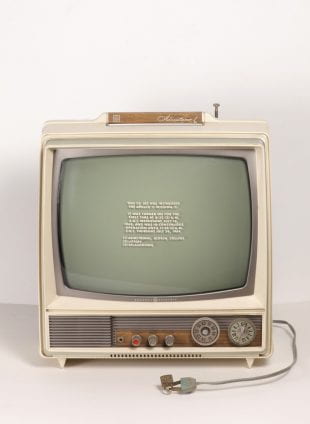
Siah Armajani, “Moon Landing,” 1969. Multimedia Sculpture using stenciled television, lock and ink on five sheets of newspaper. Television with stencil: 13 1/2 × 12 1/2 × 9” ( 34.3 × 31.8 × 22.9 cm) Courtesy of the artist and Rossi & Rossi.
Over 500 million people watched the moon landing on television. Iranian-born artist Siah Armajani, then living in Minneapolis, was no exception. In response, he created “Moon Landing” (1969). Having purchased a portable television for the occasion and turned it on for the first time as the mission began, the artist left it on continuously until the spacecraft returned safely to Earth eight days later. Armajani then disconnected the TV and locked the plug, symbolically capturing mankind’s first moon landing as a seminal moment in human history. Armajani concurrently hand-traced every word in The New York Times’ special issue dedicated to the event, each page of which is displayed in the exhibition as a tribute to human creativity and ingenuity.
The youngest artist in the exhibition, Rachel Rose, was not alive to witness the Apollo 11 mission. Her fascination with space travel came instead from the movies. Inspired by the major motion pictures “Gravity” and “Interstellar,” Rose researched space travel, interviewed astronaut David Wolf and visited the Neutral Buoyancy Research Facility at the University of Maryland. Her resulting video installation, “Everything and More” (2015), explores the bodily dislocation and perceptual confusion caused by space travel and the concept of life outside Earth’s atmosphere.
Additional works by Nancy Graves, Katy Schimert and Michelle Stuart will also be featured.
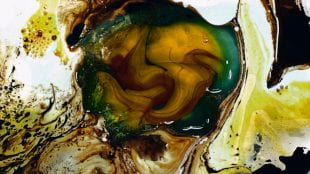
Rachel Rose. “Everything and More” (still), 2015. Courtesy of the artist, Pilar Corrias Gallery, London and Gavin Brown’s enterprise, New York/Rome.
Opening reception
Sept. 20, 6-8 p.m.
Central, Brown Foundation and Media Galleries
‘Dimensions Variable: Moonlight at the Moody’
Oct. 5, 6-8 p.m.
Activities throughout the Moody building
Moody Movie Nights
“Interstellar”
Dec. 6 at 7 p.m.
West Lawn
“Gravity”
Dec. 7 at 7 p.m.
West Lawn
All events are free and open to the public. For more information, visit moody.rice.edu.
-30-
This news release can be found online at news.rice.edu.
Follow Rice News and Media Relations via Twitter @RiceUNews.
Related information:
Moody Center for the Arts: moody.rice.edu.
Robert Rauschenberg, “Local Means (Stoned Moon),” 1970, Lithograph, 32 3/8 x 43 1/4 inches (82.2 x 110 cm). From an edition of 11, published by Gemini G.E.L., Los Angeles © Robert Rauschenberg Foundation and Gemini G.E.L.
Photo link: https://cpb-us-e1.wpmucdn.com/news-network.rice.edu/dist/c/2/files/2019/07/rauschenberg.png
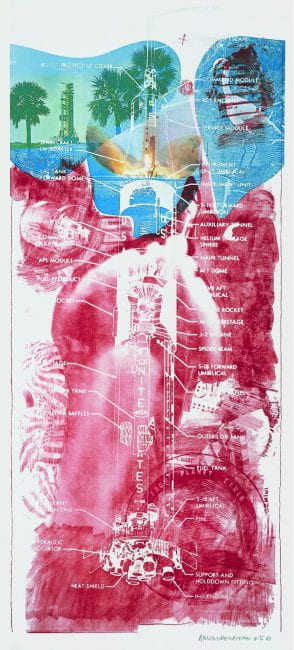
Robert Rauschenberg “Sky Garden,” 1969. 6-color lithograph/screenprint on Arjomari paper 89 x 42” (226.1 x 106.7 cm). Edition of 35 plus 6 APs. © Robert Rauschenberg Foundation and Gemini G.E.L.

Siah Armajani, “Moon Landing,” 1969. Multimedia Sculpture using stenciled television, lock and ink on five sheets of newspaper. Television with stencil: 13 1/2 × 12 1/2 × 9” ( 34.3 × 31.8 × 22.9 cm). Courtesy of the artist and Rossi & Rossi.
Photo link: https://cpb-us-e1.wpmucdn.com/news-network.rice.edu/dist/c/2/files/2019/07/Siah-Armajani-Moon-Landing.jpg
Rachel Rose. “Everything and More” (still), 2015. Courtesy of the artist, Pilar Corrias Gallery, London and Gavin Brown’s enterprise, New York/Rome.
Located on a 300-acre forested campus in Houston, Rice University is consistently ranked among the nation’s top 20 universities by U.S. News & World Report. Rice has highly respected schools of Architecture, Business, Continuing Studies, Engineering, Humanities, Music, Natural Sciences and Social Sciences and is home to the Baker Institute for Public Policy. With 3,970 undergraduates and 2,934 graduate students, Rice’s undergraduate student-to-faculty ratio is just under 6-to-1. Its residential college system builds close-knit communities and lifelong friendships, just one reason why Rice is ranked No. 1 for quality of life and for lots of race/class interaction and No. 2 for happiest students by the Princeton Review. Rice is also rated as a best value among private universities by Kiplinger’s Personal Finance.
